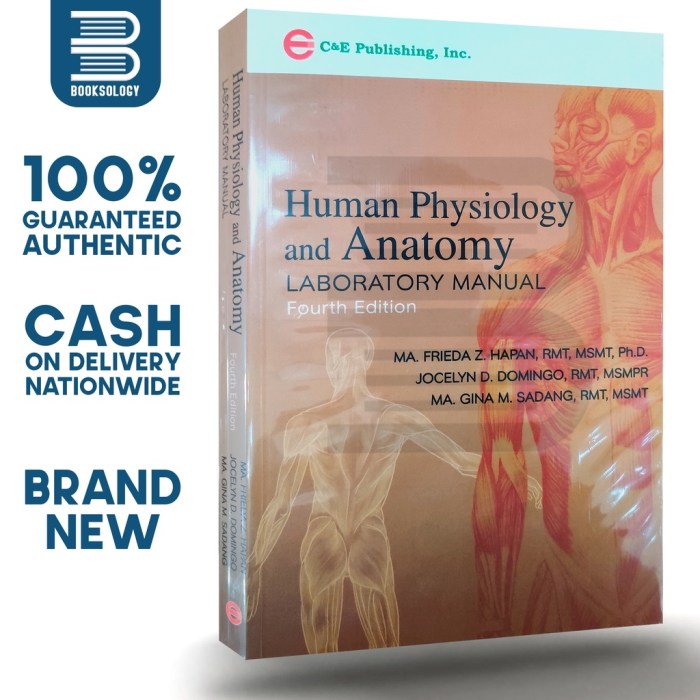Exploring anatomy & physiology in the laboratory 4th edition – Delving into Exploring Anatomy & Physiology in the Laboratory, 4th Edition, readers embark on a captivating journey into the intricacies of the human body. This authoritative text provides a comprehensive exploration of anatomical structures, physiological processes, and laboratory techniques, empowering students with a deep understanding of human biology.
Through engaging prose and meticulously crafted illustrations, this edition presents a dynamic learning experience that illuminates the complexities of anatomy and physiology. The updated content reflects the latest advancements in the field, ensuring that readers remain at the forefront of scientific knowledge.
Exploring the Field of Anatomy & Physiology

Anatomy and physiology are two closely related disciplines that study the structure and function of living organisms. Anatomy is the study of the physical structure of organisms, while physiology is the study of how these structures function. Together, anatomy and physiology provide a comprehensive understanding of the human body and its processes.
The human body is organized into several levels of organization, from the smallest atoms and molecules to the largest organs and systems. These levels of organization include the atomic level, molecular level, cellular level, tissue level, organ level, and system level.
Each level of organization is essential for the proper functioning of the body as a whole.
Studying anatomy and physiology is important for several reasons. First, it provides a foundation for understanding how the human body works. This knowledge is essential for healthcare professionals, such as doctors, nurses, and physical therapists. Second, studying anatomy and physiology can help people make healthier choices about their lifestyle.
For example, understanding how the cardiovascular system works can help people make informed decisions about diet and exercise.
Laboratory Techniques and Procedures
Laboratory techniques and procedures are essential for studying anatomy and physiology. These techniques allow scientists to observe and manipulate living organisms in a controlled environment. Some of the most common laboratory techniques include dissection, microscopy, and experimentation.
Dissection is the process of cutting open an organism to study its internal structure. Dissection can be performed on a variety of organisms, from small animals to human cadavers. Microscopy is the process of using a microscope to magnify and examine small objects.
Microscopy can be used to study cells, tissues, and organs. Experimentation is the process of testing a hypothesis by manipulating variables and observing the results. Experimentation is an essential tool for scientists, as it allows them to determine the cause-and-effect relationships between different variables.
It is important to follow proper safety procedures when working in a laboratory. These procedures include wearing appropriate clothing, using sharp instruments carefully, and disposing of chemicals properly. Following safety procedures helps to prevent accidents and injuries.
The Skeletal System
The skeletal system is composed of bones, cartilage, and ligaments. Bones are hard, mineralized tissues that provide support and protection for the body. Cartilage is a flexible, connective tissue that cushions and supports joints. Ligaments are tough, fibrous tissues that connect bones together.
The skeletal system has several functions. First, it provides support for the body. The bones of the skeleton form a framework that supports the body’s weight and allows for movement. Second, the skeletal system protects the body’s internal organs. The bones of the skull protect the brain, the bones of the rib cage protect the heart and lungs, and the bones of the pelvis protect the reproductive organs.
Third, the skeletal system stores minerals. The bones of the skeleton contain large amounts of calcium and phosphorus. These minerals are essential for the proper functioning of the body’s muscles, nerves, and cells. Fourth, the skeletal system produces blood cells.
The bone marrow inside the bones of the skeleton produces red blood cells, white blood cells, and platelets.
The Muscular System

The muscular system is composed of muscles. Muscles are soft, contractile tissues that allow for movement. There are three types of muscles: skeletal muscles, smooth muscles, and cardiac muscles.
Skeletal muscles are attached to bones and are responsible for voluntary movement. Smooth muscles are found in the walls of organs and are responsible for involuntary movement, such as the movement of food through the digestive tract. Cardiac muscles are found in the heart and are responsible for the pumping action of the heart.
The muscular system has several functions. First, it allows for movement. The muscles of the skeleton allow for voluntary movement, such as walking, running, and jumping. The muscles of the digestive tract allow for the movement of food through the digestive system.
The muscles of the heart allow for the pumping action of the heart.
Second, the muscular system provides support for the body. The muscles of the abdomen and back help to support the spine and maintain good posture. The muscles of the legs and feet help to support the body’s weight and allow for walking and running.
Third, the muscular system helps to regulate body temperature. When the body is cold, the muscles shiver to generate heat. When the body is hot, the muscles sweat to cool down the body.
Top FAQs: Exploring Anatomy & Physiology In The Laboratory 4th Edition
What are the key features of Exploring Anatomy & Physiology in the Laboratory, 4th Edition?
Exploring Anatomy & Physiology in the Laboratory, 4th Edition stands out with its comprehensive coverage of anatomical structures, physiological processes, and laboratory techniques. It incorporates the latest advancements in the field, offering students an up-to-date understanding of human biology.
How does this edition enhance the learning experience?
This edition captivates readers with engaging prose and meticulously crafted illustrations. The dynamic learning experience fosters a deep understanding of anatomy and physiology, preparing students for success in the biomedical sciences.
What is the significance of laboratory techniques in this text?
Laboratory techniques play a pivotal role in Exploring Anatomy & Physiology in the Laboratory, 4th Edition. Through hands-on exercises and dissections, students develop practical skills and gain firsthand experience in anatomical and physiological investigations.